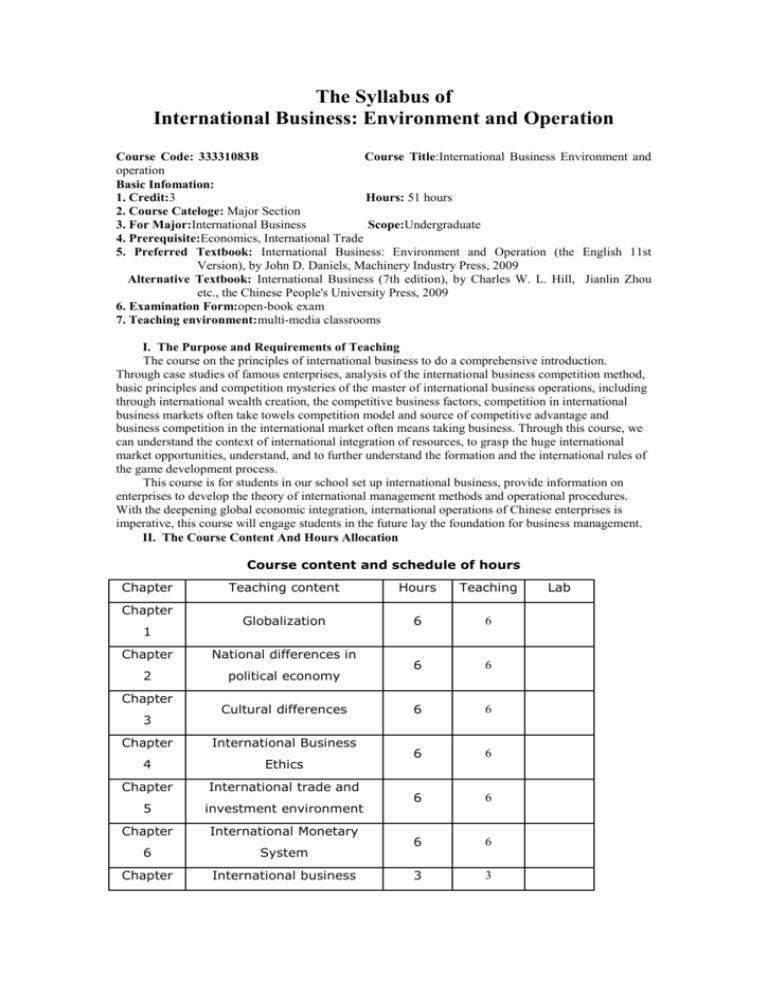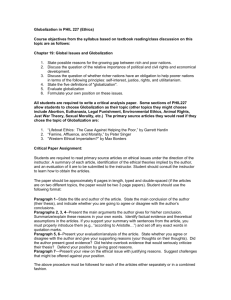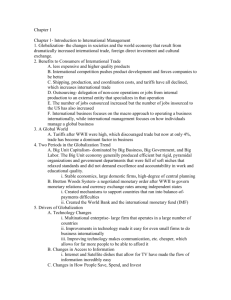The Syllabus of International Business: Environment and Operation
advertisement

The Syllabus of International Business: Environment and Operation Course Code: 33331083B Course Title:International Business Environment and operation Basic Infomation: 1. Credit:3 Hours: 51 hours 2. Course Cateloge: Major Section 3. For Major:International Business Scope:Undergraduate 4. Prerequisite:Economics, International Trade 5. Preferred Textbook: International Business: Environment and Operation (the English 11st Version), by John D. Daniels, Machinery Industry Press, 2009 Alternative Textbook: International Business (7th edition), by Charles W. L. Hill, Jianlin Zhou etc., the Chinese People's University Press, 2009 6. Examination Form:open-book exam 7. Teaching environment:multi-media classrooms I. The Purpose and Requirements of Teaching The course on the principles of international business to do a comprehensive introduction. Through case studies of famous enterprises, analysis of the international business competition method, basic principles and competition mysteries of the master of international business operations, including through international wealth creation, the competitive business factors, competition in international business markets often take towels competition model and source of competitive advantage and business competition in the international market often means taking business. Through this course, we can understand the context of international integration of resources, to grasp the huge international market opportunities, understand, and to further understand the formation and the international rules of the game development process. This course is for students in our school set up international business, provide information on enterprises to develop the theory of international management methods and operational procedures. With the deepening global economic integration, international operations of Chinese enterprises is imperative, this course will engage students in the future lay the foundation for business management. II. The Course Content And Hours Allocation Course content and schedule of hours Chapter Chapter 1 Teaching content Hours Teaching Globalization 6 6 6 6 6 6 6 6 6 6 6 6 3 3 Chapter National differences in 2 political economy Chapter 3 Cultural differences Chapter International Business 4 Ethics Chapter International trade and 5 investment environment Chapter International Monetary 6 System Chapter International business Lab 7 strategy Chapter International Business 8 Organization Chapter Entry strategies and 9 strategic alliances Chapter International Business 10 Operations Total 3 3 3 3 6 6 51 51 III The teaching content arrangement Chapter One Globalization 【Objective of Teaching】knowledgeobjectives: 1. Memorizing the meaning of economic globalization, mainly in the form of vector. 2. Understanding the essence of economic globalization, pros and cons, the attitude of developing countries in economic globalization. 3. With typical examples, the use of the knowledge, analysis of the economic globalization process, China should be how to seize opportunities and meet challenges. Capacity goal: to cultivate a dialectic, a comprehensive analysis of problems, theory with practice, the use of the knowledge of practical problems. Emotional attitude and values objectives: the challenges of globalization, the key in their own, so that the students set to study hard and strive for the rejuvenation of the nation's ambition; of the challenges we face and strengthen their sense of urgency and mission. 【Teaching Focus】economic globalization, the mainthe performance, substance and impact. 【Difficult Points】mainly of economic globalization. 【Teaching Methods】lectures 【Teaching Content】 Section 1 Trend of Eeconomic 1. 2. 3. 4. the meaning of globalization,economic globalization, the performance of economic globalization, Carriers of economic the composition of the national budget system 1. 2. 3. 4. the beneficial effects of economic globalization the real economic globalization challenges of economic globalization (adverse effects) how to deal with economic globalization Section 2 Impact of Economic Globalization 【Review Questions】 1. Analysis of economic globalization on the impact of China's economic development. Chapter Two National differences in political and economic 【Objective of Teaching】students understand and master the world economy and politics and international relations on the evolution of trends and key issues facing; knowledge and understanding of major international force in the world economy, politics status, function and their foreign strategies. 【Teaching Focus】the Cold War era of the evolution of the world economic pattern and the characteristics of the development of world economy and trends. 【Difficult Points】different models of national economies. 【Teaching Methods】lectures 【Teaching Content】 Section 1 U.S. free-market economic 1. 2. 3. meaning of the model features ways to achieve 1. 2. 3. meaning features ways to achieve 1. 2. 3. meaning features ways to achieve 1. 2. 3. meaning features ways to achieve Section 2 the German social market economy model Section 3 market economy in Japan Section 4 Welfare Market Economy 【Review Questions】 1.Do not millions of the market economy model, do you think the reality of the situation in China under the market economy in those countries should learn from there? Chapter Three Cultural differences 【Objective of Teaching】the essence of different cultures and their differences, confirm the value of cultural diversity. Capacity objectives: (1) From national holidays, cultural heritage in order to feel the charm of colorful culture. (2) the identity of different ethnic and cultural differences, respect for cultural diversity. Emotions, attitudes, values, goals: recognition of the national culture, respect for other cultures. 【Teaching Focus】to understand the world the relationship between culture and national culture, the meaning of respect for cultural diversity, the use of the principle of equality of national culture to better protect our country's traditional culture. 【Difficult Points】different models of national economies. 【Teaching Methods】lectures 【Teaching Content】 Section 1 Cultures around the World 1. 2. culture,ethnic festivals the cultural heritage 1. 2. 3. definition of cultural diversity,cultural diversity, the contents of the causes of cultural diversity 1. 2. 3. the attitude towards cultural diversity, the need for respect for cultural diversity, principles of respect for cultural diversity Section 2 Cultural diversity perspective Section 3 Respect for cultural diversity 【Review Questions】 1.How to understand the culture of both peoples, but also the world? (From the culture and personality with a common point of view) 2. Some people think that the world today, with the continuous development of science and technology and deepening economic globalization, world culture should tend to unity, and not to retain any diversity. Please analyze this point of view. 3. "Equality" is equivalent to "you, for me?" Chapter Four International Business Ethics 【Objective of Teaching】theory and practice of international business ethics issues exist to help students correctly understand the different cultural and ethical values in social systems, ethics and the problems and solutions. 【 Teaching Focus 】 ethical consideration of the missing; ethical behavior in business performance. 【Difficult Points】Ethical Lackcosts; ethical behavior in business performance. 【Teaching Methods】lectures 【Teaching Content】 Section 1 The ethical challenges of international business 1. 2. 3. the significance of ethical challenges traditionalworld ethics,businessethicaldefinition of 1. 2. 3. different interpretations of the contract,the composition ofcultures, cultural ethical relativism of 1. 2. 3. 4. corruption bribery, disaster, sophistry 1. 2. 3. aspecification,from moral theory to the specification of the need for global norms basic principles of international business ethics 1. 2. 3. 4. what is the international standard Asia European, American 1. 2. 3. Improve the ethical awareness of to implement the basic elements of master ethical issues Section 2 Ethics and Culture Section 3 the costlack of ethics Section 4 The Norm Section 5 Ethics and corporate governance Section 6 Implementation of international ethical Section 7 International perspective of business ethical 1. 2. 3. relationship management of networks types of relationships 1. 2. 3. 4. for aethics,do not want to report sexual harassment, orpersonnel arrangements,dismissal Section 8 Case study 【Review Questions】 1. 2. harshfactory environments lack of security, ethical issues be considered? Why? Test examples of the loyalty of the staff of multinational companies come from? Chapter Five International trade and investment 【 Objective of Teaching 】 on international trade and international direct investment theories and empirical, to train students to analyze economic issues of international interest and ability. The course covers merchandise trade, factor mobility and the determinants of international direct investment, government tariffs and non-tariff trade barriers, international regional economic integration. 【 Teaching Focus 】 situation in the world of international trade, free trade policies and protection of trade policies of conflict, the meaning of international investment, the role of international direct investment and development status. 【Difficult Points】free trade policy and trade policy, protection of the conflict, the role of international direct investment and development status. 【Teaching Methods】lectures 【Teaching Content】 Section 1 Economic growth and international trade 1. 2. 3. 4. 5. sources of economic growth,economic growth, the trade effect of growth conditions and benefits of trade impact of free trade theory,protectiontrade theory and policy 1. 2. Internationaldefinition of investment and type International investment and other subjectsdifference between 1. 2. 3. meaning and content of the investment environment in conflict investment environment assessment 1. 2. 3. investment,internationalthe multilateral investment agreement,regional multilateral bilateral agreements 1. 2. 3. dominance of investment internalization integrated theory of international production Section 2 International investment Section 3 International investment environment Section 4 regulations and policies Section 5 Theory of international Investment 【Review Questions】 1.Comment on China's export tax rebate policy; 2. How to assess the investment environment? 3. How direct investment? Chapter Six International Monetary System 【Objective of Teaching】the meaning of the international monetary system and stages of development, described the post-war generation and the collapse of the Bretton Woods system, the causes and characteristics of the contents of the Jamaica system, and analyzes the current reform of the international monetary system problems encountered so that the students on the development of the international monetary system have a clear understanding of, and understand the current problems in the international monetary system and reform. 【Teaching Focus】evolutionof the international monetary system, the current international monetary system, the main features and defects. 【 Difficult Points】 specific gold standard, the international monetary system defects. 【Teaching Methods】lectures 【Teaching Content】 Section 1 Outlines of the international monetary 1. 2. system,international monetary system, the meaning and content of the international monetary system,type 1. 2. gold standard system,gold standard system andgold exchange standard 1. 2. 3. 4. 5. the establishment of the Bretton Woods monetary system the Bretton Woods monetary system of the main features of the Bretton Woods monetary system and the role of the collapse of the Bretton Woods monetary system, Jamaicamonetary system 1. 2. system,thecurrent international monetary system, the main features of different countries, the Group is the attitude of the international monetary system reform, the direction of the international monetary system reform Section 2 the international gold standard Section 3 the Bretton Woods monetary system 3. Section 4 internationalreform of the monetary 【Review Questions】 1.What is the international monetary system? It includes what type? 2. What is the gold standard system, what features it has? 3. How to understand the gold standard system and the gold exchange standard? 4. What are the contents of the Bretton Woods monetary system? Its features and functions that? 5. Why the collapse of the Bretton Woods monetary system? 6. Jamaica What are the main contents of the agreement? 7. What are the existing features of the international monetary system? 8. The world's major countries and groups of countries on the reform of the international monetary system's stance? Chapter Seven The International business strategy 【Objective of Teaching】various types of international strategy, content, and advantages and disadvantages. Multinational M & A strategy and master key international strategic alliances. 【 Teaching Focus 】 contact the currentthe background of economic globalization, to grasp the basic content of each strategy and suitable conditions to compare the advantages and disadvantages of various strategies, and according to actual circumstances and conditions, flexible use of various strategies. 【Difficult Points】a variety of business strategyThe meaning and advantages and disadvantages, and how to implement. 【Teaching Methods】lectures 【Teaching Content】 Section 1 Product Export Strategy 1. 2. 3. ,the meaning ofstrategic exports,exports ofstrategic advantages,disadvantages of strategic exports 1. 2. trade agreement franchise 1. 2. strategy transnational enterprises 1. 2. 3. 4. 5. alliance,the concept of production and development of conditions for the formation of the leaguetypes, advantages and disadvantages of Section 2 strategy contract Section 3 Foreign Directinvestment Section 4 International strategic 【Review Questions】 1.Advantages and disadvantages of products which export strategy? 2. Contractual agreement to form and content strategy for what? 3. Licensing trade, which have their own advantages and disadvantages of franchising? 4. International Strategic Alliance Formation, type? 5. International strategic alliances and weaknesses? Chapter Eight the International Business Organization 【Objective of Teaching】in international business activities, the evolution of organizational structure; familiar with the international structure of the basic form of organization; master of organizational choice factors. 【 Teaching Focus 】 various forms of corporate legal structure, different corporate governance structure, how companies choose their own organizational structure. 【Difficult Points】various business management organizational structure, how companies choose their own organizational structure. 【Teaching Methods】lectures 【Teaching Content】 Section 1 legal form of Corporate 1. 2. 3. 4. organization,individual enterprises partnerships, limited liability company Co., Ltd. Section 2 Corporate Management 1. 2. 3. 4. structure,theexport structure ofDepartment, parent-subsidiary structure of the International Department of the structure global structure Section 3 the organizational structure of the third quarter and set up choice 3. choose business organization,business choice of the structuref foreign organizations,structure set 1. 2. the organizational control Model the choice of mode of organizational control factors to be considered 1. 2. basic principles of organizational Section 4 the organizational control mode 【Review Questions】 1.Corporate legal form of organization are there? 2. Brief business organization and management of international operations in the form of evolution. 3. International Department organizational structure What are the characteristics? 4. What is the organizational structure of globalization? What are the basic forms of concrete? 5. Brief business organization selected basic principles. 6. Enterprise to choose the control mode of organization? Chapter Nine Entry strategies 【Objective of Teaching】to make students adapt to the trend of globalization requirements, in other related management and economic courses, based on further enhancing the understanding of international business. 【Teaching Focus】marketing strategythe meaning and how to implement, how to simply management and benchmarking SWOT analysis, international business development strategy. 【Difficult Points】SWOT analysis, international business development strategy. 【Teaching Methods】lectures 【Teaching Content】 Section 1 Outlines marketing 1. 2. 3. strategy,marketing,strategic management process of "benchmarking" Management SWOT analysis 1. 2. 3. theexport entry mode the contract into the mode mode of investment 1. 2. 3. the scope of international market development strategy for international market development strategy,international market development strategy formeans 1. 2. 3. competition,themarket leader in strategy market challenger strategy the market follower strategy Section 2 International market entry strategy Section 3 international market development Strategy the fourth quarterstrategy of international market 4. the market filled by strategy 【Review Questions】 1.How to develop marketing strategy? 2, What is the benchmarking management? 3, international market entry strategy which mode? 4, the international market development strategy involves the specific strategy? 5, how enterprises according to their position in the market to develop competitive strategy? Chapter Ten International Business 【Objective of Teaching】the process of enterprises as in international business management problems and solutions to, and can be combined with the practical application of knowledge and case analysis. . 【 Teaching Focus 】 international operationsthe meaning, characteristics and stage, the basic strategy of international business operations and organizational security. 【Difficult Points】the basic strategy of international business operations. 【Teaching Methods】lectures 【Teaching Content】 Section 1 Substantial International Management 1. 2. 3. operations,international mobility and the barriers to generation of international operations,international operationsconcept 1. 2. 3. the main body of international operations - Enterprise Enterpriseof the four changes in behavior,characteristics of multinational enterprises Section 2 management of the International Section Section 3 Four stages of international operations business 1. 2. 3. 4. the four International Operation Phase multi-national organizational structure ofcompanies, multinational corporations characteristics of the rapid development of the international management of issues 1. 2. 3. 4. 5. 6. 7. strategy,the basic theory of international operations entrepreneurs should consider the question international market, market definition,investment feasibility studies the highest among the international operations of the seven operators of the role international business survey methods,the basic strategic framework to determine 1. 2. 3. 4. operation,exporting turnkey projects,licensing and franchising business joint Section 4 Basic International operationbasic Section 5 Mode of international 5. ventures,wholly owned subsidiary of Section 6 the organization of international operations protect 1. 2. 3. 4. 5. 6. 7. internal support system,management guidelines to develop oroperators the choice of personnel,branches and subsidiaries and their connection subsidiaries Management parent company's management and control model multinational business organizations of which the design 【Review Questions】 1.If you are a business leader, you encounter different views on how to deal with the time?





